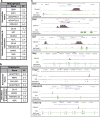DLX3 regulates bone mass by targeting genes supporting osteoblast differentiation and mineral homeostasis in vivo
- PMID: 24948010
- PMCID: PMC4131184
- DOI: 10.1038/cdd.2014.82
DLX3 regulates bone mass by targeting genes supporting osteoblast differentiation and mineral homeostasis in vivo
Abstract
Human mutations and in vitro studies indicate that DLX3 has a crucial function in bone development, however, the in vivo role of DLX3 in endochondral ossification has not been established. Here, we identify DLX3 as a central attenuator of adult bone mass in the appendicular skeleton. Dynamic bone formation, histologic and micro-computed tomography analyses demonstrate that in vivo DLX3 conditional loss of function in mesenchymal cells (Prx1-Cre) and osteoblasts (OCN-Cre) results in increased bone mass accrual observed as early as 2 weeks that remains elevated throughout the lifespan owing to increased osteoblast activity and increased expression of bone matrix genes. Dlx3OCN-conditional knockout mice have more trabeculae that extend deeper in the medullary cavity and thicker cortical bone with an increased mineral apposition rate, decreased bone mineral density and increased cortical porosity. Trabecular TRAP staining and site-specific Q-PCR demonstrated that osteoclastic resorption remained normal on trabecular bone, whereas cortical bone exhibited altered osteoclast patterning on the periosteal surface associated with high Opg/Rankl ratios. Using RNA sequencing and chromatin immunoprecipitation-Seq analyses, we demonstrate that DLX3 regulates transcription factors crucial for bone formation such as Dlx5, Dlx6, Runx2 and Sp7 as well as genes important to mineral deposition (Ibsp, Enpp1, Mepe) and bone turnover (Opg). Furthermore, with the removal of DLX3, we observe increased occupancy of DLX5, as well as increased and earlier occupancy of RUNX2 on the bone-specific osteocalcin promoter. Together, these findings provide novel insight into mechanisms by which DLX3 attenuates bone mass accrual to support bone homeostasis by osteogenic gene pathway regulation.
Figures







Comment in
-
Dlx genes and the maintenance of bone homeostasis and skeletal integrity.Cell Death Differ. 2014 Sep;21(9):1345-6. doi: 10.1038/cdd.2014.94. Cell Death Differ. 2014. PMID: 25109593 Free PMC article. No abstract available.
References
-
- Cohen MM., Jr Perspectives on RUNX genes: an update. Am J Med Genet A. 2009;149A:2629–2646. - PubMed
-
- Long F. Building strong bones: molecular regulation of the osteoblast lineage. Nat Rev Mol Cell Biol. 2012;13:27–38. - PubMed
-
- Panganiban G, Rubenstein JL. Developmental functions of the Distal-less/Dlx homeobox genes. Development. 2002;129:4371–4386. - PubMed
Publication types
MeSH terms
Substances
Grants and funding
LinkOut - more resources
Full Text Sources
Other Literature Sources
Medical
Molecular Biology Databases
Miscellaneous

